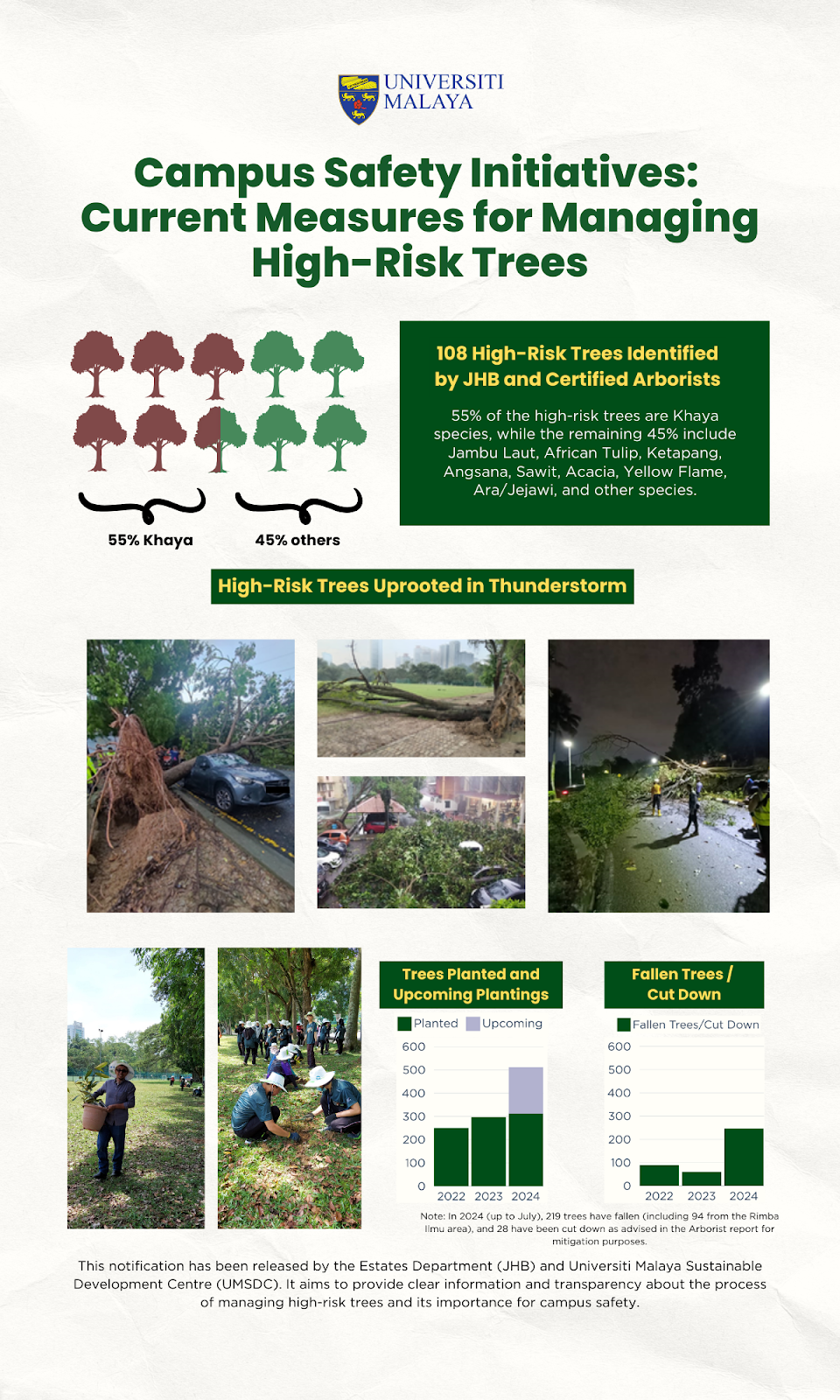
1. We truly appreciate the many benefits trees provide, from cooling the urban heat island effect and improving air quality to supporting the mental and physical well-being of both staff and students. In 2015, Estates Department (JHB) mapped approximately 5,287 shade trees on the campus, covering key areas of UM including Lingkungan Budi, Tasik Varsiti, Dewan Tunku Canselor (DTC), Kompleks Perdana Siswa (KPS), the Main Library, and all faculties. It is estimated that 80% of the 5,287 shade trees are over 30 years old and require more careful attention.
2. Having said that, you may have noticed some recent tree removals in UM. These actions are necessary as JHB and certified arborists have identified 108 high-risk trees that need to be removed to ensure everyone's safety. As we continue to conduct risk assessments on tree health, additional trees may be added to the list, with removals scheduled periodically until April 2025 to minimize disruption. We’re addressing the need to remove the high-risk trees, as we’ve discovered they were planted in less-than-ideal locations. Moving forward, we are committed to making better choices to ensure our campus greenery thrives.
3. Among the 108 trees to be felled, 55% are Khaya senegalensis / Khaya ivorensis (Khaya), a non-native species from Africa. Although it is a fast-growing tree that provides immediate cooling to its surroundings, Khaya has a tendency to uproot, especially during thunderstorms, which is concerning. Khaya is also a high-maintenance tree, with roots that can quickly spread and cause damage to building structures, drains, roads, parking lots, footpaths, and underground utilities. Certified arborists conducted inspections in 2013, 2015, 2019, and most recently in 2023 and 2024, recommending closer scrutiny of Khaya trees and advising against planting them in the future. Unfortunately, relocating the Khaya trees and other high-risk trees is not feasible due to their large size, high transplantation costs, and low survival rates. Additionally, these trees are not classified as endangered or rare species.
4. The decision to cut down these high-risk trees was not made lightly. During the recent thunderstorm in May 2024, on two separate dates, 120 high-risk trees were uprooted and fell, blocking roads and damaging several parked vehicles. UM is still awaiting feedback from the appointed insurance company regarding the actual amount of loss caused by the tree felling. We are also very thankful that no lives were lost during the thunderstorm. Notably, 30% of the trees that fell were Khaya trees.
5. As part of our mitigation plan, JHB will release a new guideline on tree maintenance this year. This guideline will serve as a reference for selecting appropriate tree species based on the usage and size of various areas, and for creating essential habitats for a range of species, including birds, small mammals, and insects. It will also include a list of banned tree species with problematic characteristics such as aggressive root systems, thorny, susceptibility to fungal infections, and toxicity.
6. We understand that this news may be surprising, given the importance of trees on our campus. In alignment with the university's commitment to sustainable landscape management, 100 new trees, adhering to the new guideline, are scheduled to be planted in September 2024 to offset the loss of the felled trees. This effort is part of the university's ongoing pledge to plant at least 200 trees and 500 shrubs annually. While the majority of these trees will not be planted in high-traffic areas, they will nonetheless contribute to increasing our green cover. Additionally, it's important to note that in 2023, the JHB Landscape Section planted 297 shade tree saplings of forest species from FRIM Kepong at UM, achieving a 100% survival rate. This is part of the urban forestry program, where the trees were selected based on their tolerance to urban environments.
We welcome any suggestions or feedback you may have regarding this matter and sincerely apologize for any inconvenience caused. Please direct your comments to Encik Abd Haris Yaacub (abd.haris@um.edu.my), Encik Mohd Razman Anuar (razmana@um.edu.my) or Encik Hisyamuddin Che Harun (hisyamuddin@um.edu.my) from the JHB Landscape Section.
Note: This notification has been released by the Estates Department (JHB) and Universiti Malaya Sustainable Development Centre (UMSDC). It aims to provide clear information and transparency about the process of managing high-risk trees and its importance for campus safety.